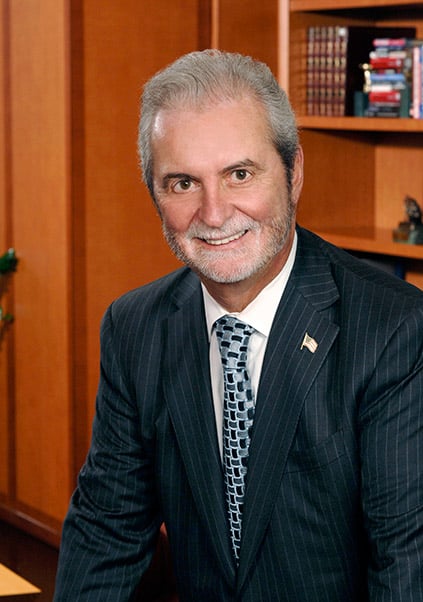Convertibles: Providing Risk Management and Positioned for a Snapback
First published: March 20, 2020
In a turbulent period for the markets, Calamos is hosting a Calamos CIO Conference Call Series for financial advisors. Immediately below are notes from a call Tuesday, March 24, with Calamos Founder, Chairman and Global Chief Investment Officer John P. Calamos, Sr., and Joe Wysocki, CFA, Senior Vice President, Co-Portfolio Manager.
To listen to the call in its entirety, go to www.calamos.com/CIOconvertibles-3-24.
These comments build on commentary from a March 17 call with Wysocki and Jon Vacko, CFA, Senior Vice President, Co-Portfolio Manager. You’ll see those notes below. To listen to the March 17 call in its entirety, go to www.calamos.com/CIOconvertibles.
Also, for additional insight, see Calamos Risk-Managed Funds Show Resilience in March Madness and Back At It Again: How Calamos Convertible Funds Protected Against February’s Downside.
March 24 Update

“This recovery will be better than most people think. Technology is fast moving, whether it’s bio tech or whether it’s something else. It’s not going to take two years to figure this out.”
- Today’s markets remind Calamos Founder, Chairman and Global Investment Officer John P. Calamos, Sr., of the 1987 market crash, which was followed by a V-shaped recovery. Given the speed with which technology innovates, John expects biotech will need fewer than two years to address the COVID-19 outbreak. Forward-looking markets will anticipate the development as well as the implications for the economy.
- John stressed the futility of trying to time the markets. John, a pioneer in the use of convertible securities to manage downside risk, advocated convertibles as a means of riding out volatility—and assuring that clients are positioned to benefit when the market turns.
- For issuers, convertibles are all about providing access to capital. John believes that we’re in one of those periods when access to capital will be very important.
- In the near term, markets can be expected to continue to react to headlines, including about the strength of the economy. John emphasized the need for Congress to act to support the private sector.
A 3-Part Market
Joe says the convertible market continues to be orderly. Despite the fact that equities are down, spreads are wider and theoretical valuations are off 3%-4%, trading is happening. In fact, volumes are up from what has been typical this time of year and higher than one month ago.
He characterizes the market as split into three buckets:
- Solvency concerns that are deeply discounted: These include typically cyclical areas with known issues, directly impacted by the economic slowdown. Some had weaker balance sheets coming into this and faced sharp declines right away. Price discovery in this space is challenging as liquidity is not great.
- Perceived winners: Areas that could stand to benefit coming out of this include some select areas of technology, health care or consumer sectors. In many cases, the stocks have not declined as much as the market, credit spreads are wider but reasonable, balanced converts in this space are generally well bid for, and discounts are narrower than the overall market.
- Everything else: These companies don’t have solvency issues with the credit, businesses will survive but face some degree of challenges. Trading liquidity is ok but there are wider bid ask spreads.
In general, if you’re a seller you may not necessarily like the prices you’re looking at but you are able to sell if you need/want to. If you’re a buyer you’re not seeing liquidation bids being hit across the board like what occurred in 2009. Here, shorter dated, higher quality paper is holding up well.
Sizing Up the Opportunities
Our strategy continues to be to stay disciplined to our process. We focus on the risk/reward of individual names and the portfolio as a whole.
We seek to preserve capital. These are volatile and uncertain times, so we need to mitigate the risk on the downside.
Through yesterday, March 23, the ICE BofA All U.S. Convertibles Index (VXA0) was at -20% vs. -30% for the S&P 500—a difference of 1000 bps of outperformance. Since 1997 we have had 26 negative quarters, and converts have outperformed in 20 of them.
At the same time, the flipside of volatility is opportunity, and we are looking to take advantage of:
- Fundamentals. The opportunity is to consolidate around favored names exposed to existing themes that will persist and new ones that will emerge from recent developments themes:
- Health care: telehealth adoption, pharma/biotech, research budgets, stockpiling of supplies.
- Information Technology: distributed workforces, telecommuting, SaaS/cloud, IT infrastructure/security
- Consumer: virtual entertainment, streaming of content
- The big get bigger: those with capital and resources will survive and thrive
- Cheap convertibles. We will eventually see the combined forces of equity upside, credit upside and convert valuation gaps closing. This is what Calamos has dubbed the “convertible trifecta,” which can be very powerful on the way back up.
- Equities. We are seeing stock valuations that we have not seen in some time. We have been evaluating some areas of the market which are approaching recessionary type pricing, where businesses are priced as if they are permanently impaired and will never generate a sufficient return on capital—but even those that are not to that level yet have seen a broad revaluation lower.
- Credit. Spreads have widened across the board and we think this is creating an opportunity where in select areas we are being compensated for the risk.
Summary of Key Views (As of March 17, 2020)
- The risk mitigation that convertible securities have historically provided against the broader equity market is still intact. Since 1997, the S&P 500 has had 26 negative quarters and convertibles have outperformed in 20 of them. The quarter isn’t over yet but through Monday, March 16, the ICE BofA All U.S. Convertibles Index (VXA0) is down -17% vs. the S&P down -26%.
- We are looking at a market that has seen stocks decline 40% on average, credit spreads widen and further buying of securities at a theoretical discount to fair value. The team is looking for the reappearance of a “trifecta” opportunity, which presents itself with the combined forces of equity upside, credit upside and convert valuation gaps closing. Historically, this snapback has been very positive for investors—and could pose a tactical opportunity.
- Active management and an established credit process will be key at a time when the market is at 2009-levels, with about 50% busted converts.


“When markets eventually calm, the team would expect to see the combined forces of equity upside, credit upside and convert valuation gaps closing, which can be very powerful on the way back up.”
The team highlighted three main themes. Remember that a convertible is a hybrid security that has both equity and debt characteristics.
-
Convert issuers have been harder hit. From an equity perspective, the average convert issuer equity is down approximately 40% from the recent peak to trough. That compares to 30% for the S&P.
There has been indiscriminate selling across all areas of the market. Being more mid-cap, higher growth and in some cases higher valuation has been a headwind for convert issuers.
But while the equity is down 40%, convertible securities fared much better. They are down 24% from peak to trough, capturing approximately 60% of the downside of the underlying. So, structures are still providing downside risk mitigation albeit a bit higher than one would expect from an equity move alone. The team attributes this to the second theme, credit spreads. - Credit spreads are also being pressured, credit markets are also under stress. The energy complex is priced for bankruptcy for all intents and purposes. This creates a second headwind for convertibles as the bond portion of the structure gets repriced.
-
The overall market is cheapening up. This refers to the convertible theoretical value. A convertible bond is basically a traditional bond plus an equity call option. One could price each of these pieces and come up with a fair value for the convertible security.
In normal times, when valuations diverge, one can hedge away both the credit and equity risk and capture any valuation gap. This typically keeps things relatively close to fair value. But today we’re not seeing normal times. Liquidity is at a premium, leverage is being taken down so these dislocations are not being taken advantage of as quickly as they normally are.
Convert undervaluations tend to not persist for long periods of time. Each time is different so there is no rule of thumb as to how long it can last, but since the risk of converts can be hedged out, they tend to snap back as soon as the periods of extreme volatility subsides. Historically, it has been weeks not months.
If you compare today’s market dynamics to history, this combination is:
- more like 2016 when energy went into recession and high yields came under pressure
- with some similarities to 2009 when liquidity dried up
- a bit different from the most recent downturn in the fourth quarter of 2018, when there was a 20% decline in equities, spreads widened but converts didn’t cheapen up
Outlook and Opportunity
From an equity perspective: We are seeing stock valuations that we have not seen in some time. We have been evaluating some areas of the market that are approaching recessionary type pricing, where businesses are priced as if they are permanently impaired and will never generate a sufficient return on capital. Even areas that are not yet to that level have seen a broad revaluation lower.
From a credit perspective: Spreads have widened across the board and we believe this is creating an opportunity where in select areas we are being compensated for the risk we’re taking.
Growth potential: Remember that we have had two years of very strong convert new issuance. Many of these companies have yet to deploy that capital in a meaningful way so they have solid cash balances. These secular growth companies now are in position to take advantage of dislocations.
Recall that the convert market is not a cyclical or distressed market as the high yield market can be at times. This is a mid-cap growth market with secular opportunities, not over-levered private leveraged buyouts.
Put it together and the stage is being set for what we internally call the “convertible trifecta.” From a high level, we are looking at a market that has seen stocks decline 40% on average, credit spreads widening and further buying of securities at a theoretical discount to fair value. The markets are uncertain right now. But when markets eventually calm, the team would expect to see the combined forces of equity upside, credit upside and convert valuation gaps closing, which can be very powerful on the way back up.
The Team’s Approach
- Stay disciplined to our process. The flipside of volatility is opportunity, we know. We’re looking to consolidate around favorite names exposed to existing themes that will persist and to new ones that will emerge from recent developments. The themes include:
- Health care: telehealth adoption, pharma/biotech, research budgets, stockpiling of supplies
- IT: distributed workforces, telecommuting, SaaS/Cloud, IT infrastructure/Security
- Consumer: virtual entertainment, streaming
- The big will get bigger—those with capital and resources will survive and thrive
-
Active management in convertibles will be key. The sharp equity declines have created more busted converts. Currently, more than 90% of convert issuer equities are 20%+ below 52-week highs. At our last check, 50% of the market was considered busted, which is near the peak of 2009. Many of these held up well, all things considered, but may not participate in the eventual recovery. Rebalancing is key.
The team also emphasized the importance of the Calamos credit process and years of experience, which takes on added value at this time given that so much of the market is unrated.
Financial advisors, for more information on convertible securities, talk to your Calamos Investment Consultant at 888-571-2567 or caminfo@calamos.com.
Before investing, carefully consider the fund’s investment objectives, risks, charges and expenses. Please see the prospectus and summary prospectus containing this and other information which can be obtained by calling 1-866-363-9219. Read it carefully before investing.
Opinions are subject to change due to changes in the market, economic conditions or changes in the legal and/or regulatory environment and may not necessarily come to pass. This information is provided for informational purposes only and should not be considered tax, legal, or investment advice. References to specific securities, asset classes and financial markets are for illustrative purposes only and are not intended to be, and should not be interpreted as, recommendations.
Important Risk Information. An investment in the Fund(s) is subject to risks, and you could lose money on your investment in the Fund(s). There can be no assurance that the Fund(s) will achieve its investment objective. Your investment in the Fund(s) is not a deposit in a bank and is not insured or guaranteed by the Federal Deposit Insurance Corporation (FDIC) or any other government agency. The risks associated with an investment in the Fund(s) can increase during times of significant market volatility. The Fund(s) also has specific principal risks, which are described below. More detailed information regarding these risks can be found in the Fund's prospectus.
The principal risks of investing in the Calamos Convertible Fund include: convertible securities risk consisting of the potential for a decline in value during periods of rising interest rates and the risk of the borrower to miss payments, synthetic convertible instruments risk consisting of fluctuations inconsistent with a convertible security and the risk of components expiring worthless, foreign securities risk, equity securities risk, interest rate risk, credit risk, high yield risk, portfolio selection risk and liquidity risk. As a result of political or economic instability in foreign countries, there can be special risks associated with investing in foreign securities, including fluctuations in currency exchange rates, increased price volatility and difficulty obtaining information. In addition, emerging markets may present additional risk due to potential for greater economic and political instability in less developed countries.
NOT FDIC INSURED | NO BANK GUARANTEE | MAY LOSE VALUE
801945 0320
Archived material may contain dated performance, risk and other information. Current performance may be lower or higher than the performance quoted in the archived material. For the most recent month-end fund performance information visit www.calamos.com. Archived material may contain dated opinions and estimates based on our judgment and are subject to change without notice, as are statements of financial market trends, which are based on current market conditions at the time of publishing. We believed the information provided here was reliable, but do not warrant its accuracy or completeness. This material is not intended as an offer or solicitation for the purchase or sale of any financial instrument. The views and strategies described may not be suitable for all investors. This material has been prepared for informational purposes only, and is not intended to provide, and should not be relied on for, accounting, legal or tax advice. References to future returns are not promises or even estimates of actual returns a client portfolio may achieve. Any forecasts contained herein are for illustrative purposes only and are not to be relied upon as advice or interpreted as a recommendation.
Performance data quoted represents past performance, which is no guarantee of future results. Current performance may be lower or higher than the performance quoted. The principal value and return of an investment will fluctuate so that your shares, when redeemed, may be worth more or less than their original cost. Performance reflected at NAV does not include the Fund’s maximum front-end sales load. Had it been included, the Fund’s return would have been lower.
Archived material may contain dated performance, risk and other information. Current performance may be lower or higher than the performance quoted in the archived material. For the most recent month-end fund performance information visit www.calamos.com. Archived material may contain dated opinions and estimates based on our judgment and are subject to change without notice, as are statements of financial market trends, which are based on current market conditions at the time of publishing. We believed the information provided here was reliable, but do not warrant its accuracy or completeness. This material is not intended as an offer or solicitation for the purchase or sale of any financial instrument. The views and strategies described may not be suitable for all investors. This material has been prepared for informational purposes only, and is not intended to provide, and should not be relied on for, accounting, legal or tax advice. References to future returns are not promises or even estimates of actual returns a client portfolio may achieve. Any forecasts contained herein are for illustrative purposes only and are not to be relied upon as advice or interpreted as a recommendation.
Performance data quoted represents past performance, which is no guarantee of future results. Current performance may be lower or higher than the performance quoted. The principal value and return of an investment will fluctuate so that your shares, when redeemed, may be worth more or less than their original cost. Performance reflected at NAV does not include the Fund’s maximum front-end sales load. Had it been included, the Fund’s return would have been lower.
Archived on March 19, 2021Cookies
This website uses cookies. By continuing to use this website, you consent to the use of cookies. Learn more about our cookie usage.

